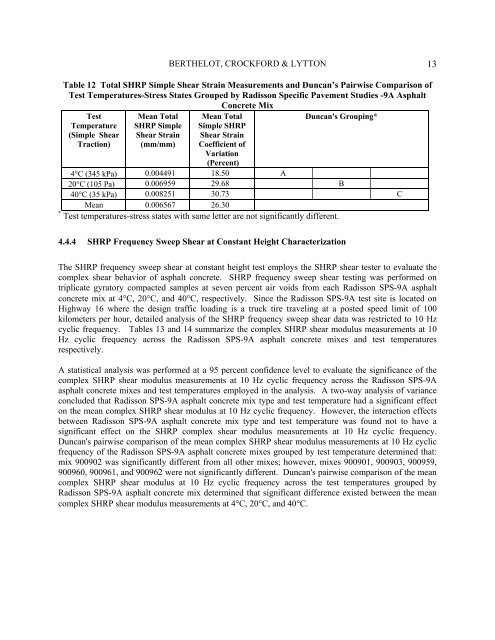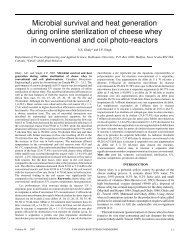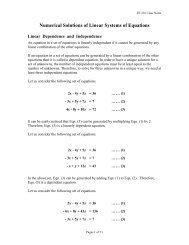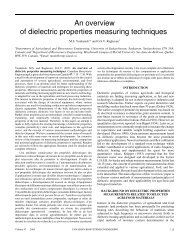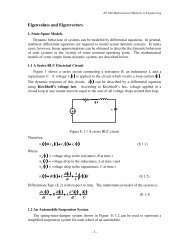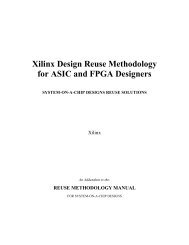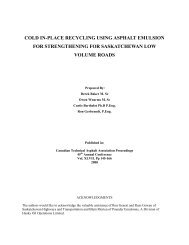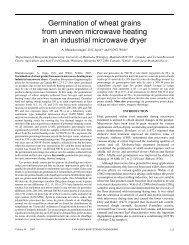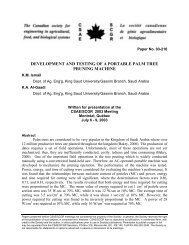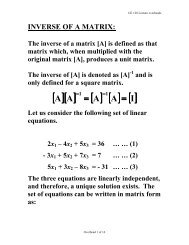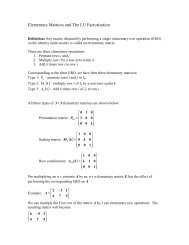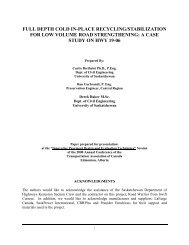comparison of alternative asphalt concrete rut characterization
comparison of alternative asphalt concrete rut characterization
comparison of alternative asphalt concrete rut characterization
You also want an ePaper? Increase the reach of your titles
YUMPU automatically turns print PDFs into web optimized ePapers that Google loves.
BERTHELOT, CROCKFORD & LYTTON 13Table 12 Total SHRP Simple Shear Strain Measurements and Duncan’s Pairwise Comparison <strong>of</strong>Test Temperatures-Stress States Grouped by Radisson Specific Pavement Studies -9A AsphaltConcrete MixTestTemperature(Simple ShearTraction)Mean TotalSHRP SimpleShear Strain(mm/mm)Mean TotalSimple SHRPShear StrainCoefficient <strong>of</strong>Variation(Percent)Duncan's Grouping*4°C (345 kPa) 0.004491 18.50 A20°C (105 Pa) 0.006959 29.68 B40°C (35 kPa) 0.008251 30.73 CMean 0.006567 26.30* Test temperatures-stress states with same letter are not significantly different.4.4.4 SHRP Frequency Sweep Shear at Constant Height CharacterizationThe SHRP frequency sweep shear at constant height test employs the SHRP shear tester to evaluate thecomplex shear behavior <strong>of</strong> <strong>asphalt</strong> <strong>concrete</strong>. SHRP frequency sweep shear testing was performed ontriplicate gyratory compacted samples at seven percent air voids from each Radisson SPS-9A <strong>asphalt</strong><strong>concrete</strong> mix at 4°C, 20°C, and 40°C, respectively. Since the Radisson SPS-9A test site is located onHighway 16 where the design traffic loading is a truck tire traveling at a posted speed limit <strong>of</strong> 100kilometers per hour, detailed analysis <strong>of</strong> the SHRP frequency sweep shear data was restricted to 10 Hzcyclic frequency. Tables 13 and 14 summarize the complex SHRP shear modulus measurements at 10Hz cyclic frequency across the Radisson SPS-9A <strong>asphalt</strong> <strong>concrete</strong> mixes and test temperaturesrespectively.A statistical analysis was performed at a 95 percent confidence level to evaluate the significance <strong>of</strong> thecomplex SHRP shear modulus measurements at 10 Hz cyclic frequency across the Radisson SPS-9A<strong>asphalt</strong> <strong>concrete</strong> mixes and test temperatures employed in the analysis. A two-way analysis <strong>of</strong> varianceconcluded that Radisson SPS-9A <strong>asphalt</strong> <strong>concrete</strong> mix type and test temperature had a significant effecton the mean complex SHRP shear modulus at 10 Hz cyclic frequency. However, the interaction effectsbetween Radisson SPS-9A <strong>asphalt</strong> <strong>concrete</strong> mix type and test temperature was found not to have asignificant effect on the SHRP complex shear modulus measurements at 10 Hz cyclic frequency.Duncan's pairwise <strong>comparison</strong> <strong>of</strong> the mean complex SHRP shear modulus measurements at 10 Hz cyclicfrequency <strong>of</strong> the Radisson SPS-9A <strong>asphalt</strong> <strong>concrete</strong> mixes grouped by test temperature determined that:mix 900902 was significantly different from all other mixes; however, mixes 900901, 900903, 900959,900960, 900961, and 900962 were not significantly different. Duncan's pairwise <strong>comparison</strong> <strong>of</strong> the meancomplex SHRP shear modulus at 10 Hz cyclic frequency across the test temperatures grouped byRadisson SPS-9A <strong>asphalt</strong> <strong>concrete</strong> mix determined that significant difference existed between the meancomplex SHRP shear modulus measurements at 4°C, 20°C, and 40°C.


